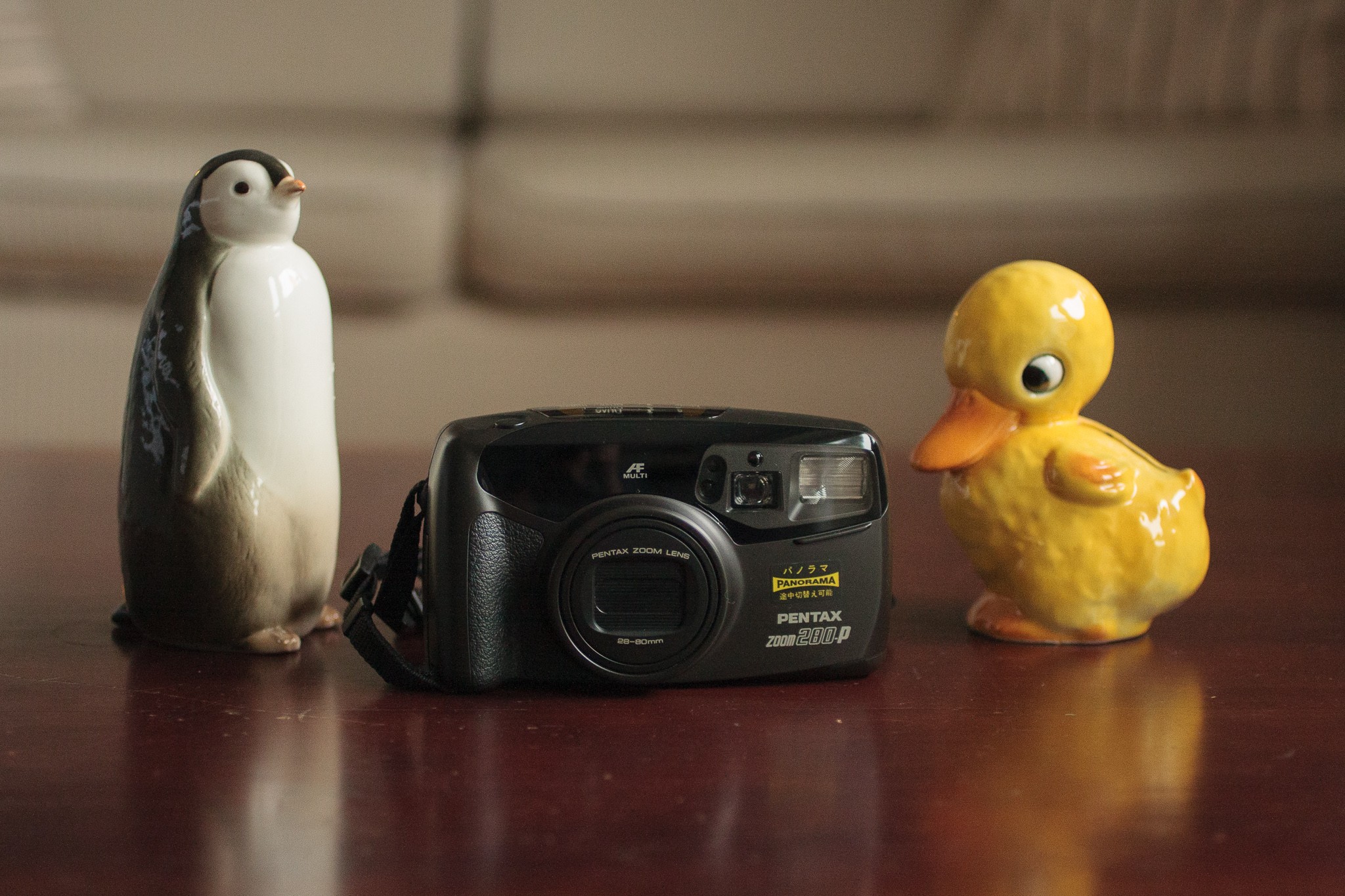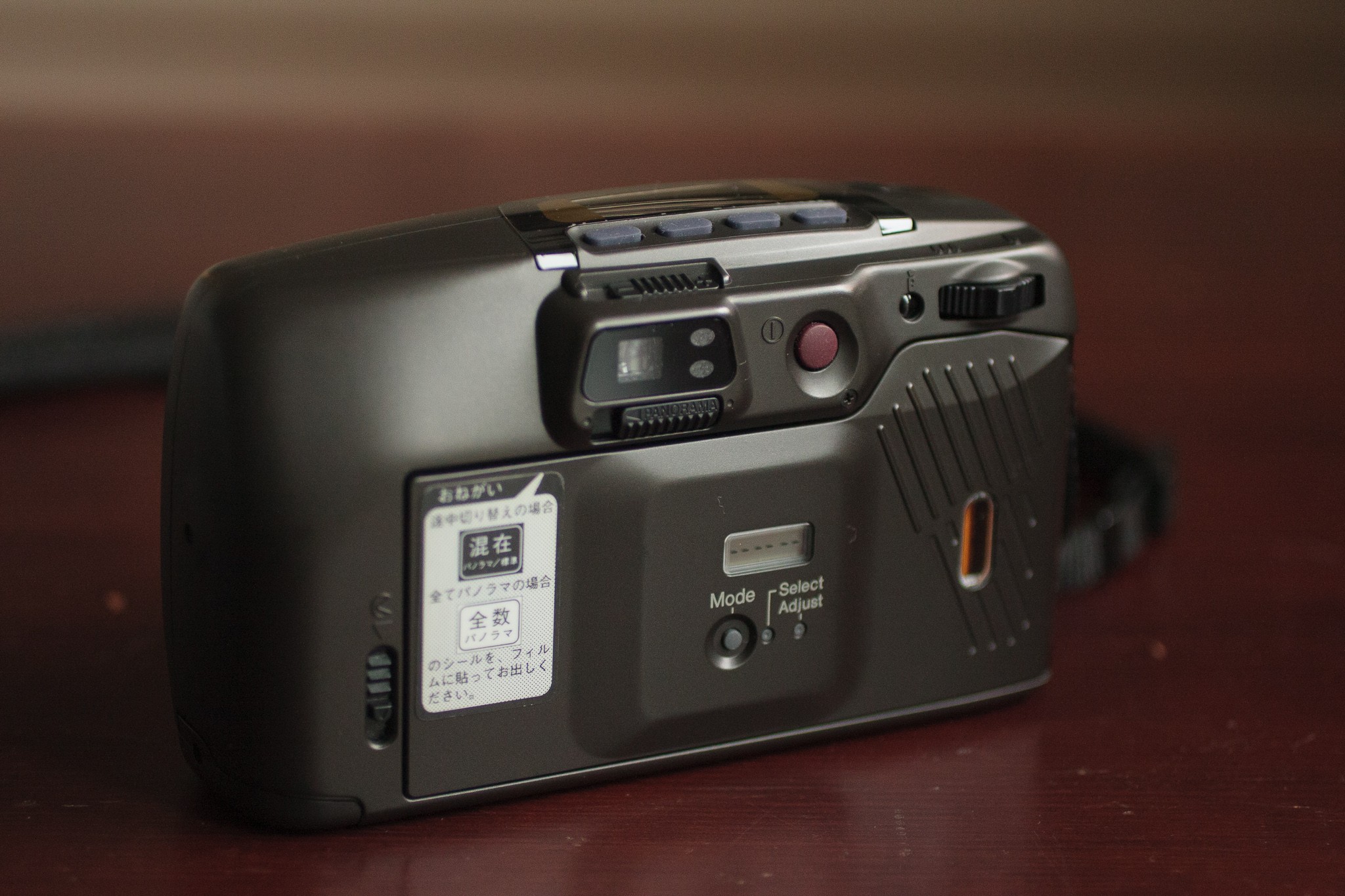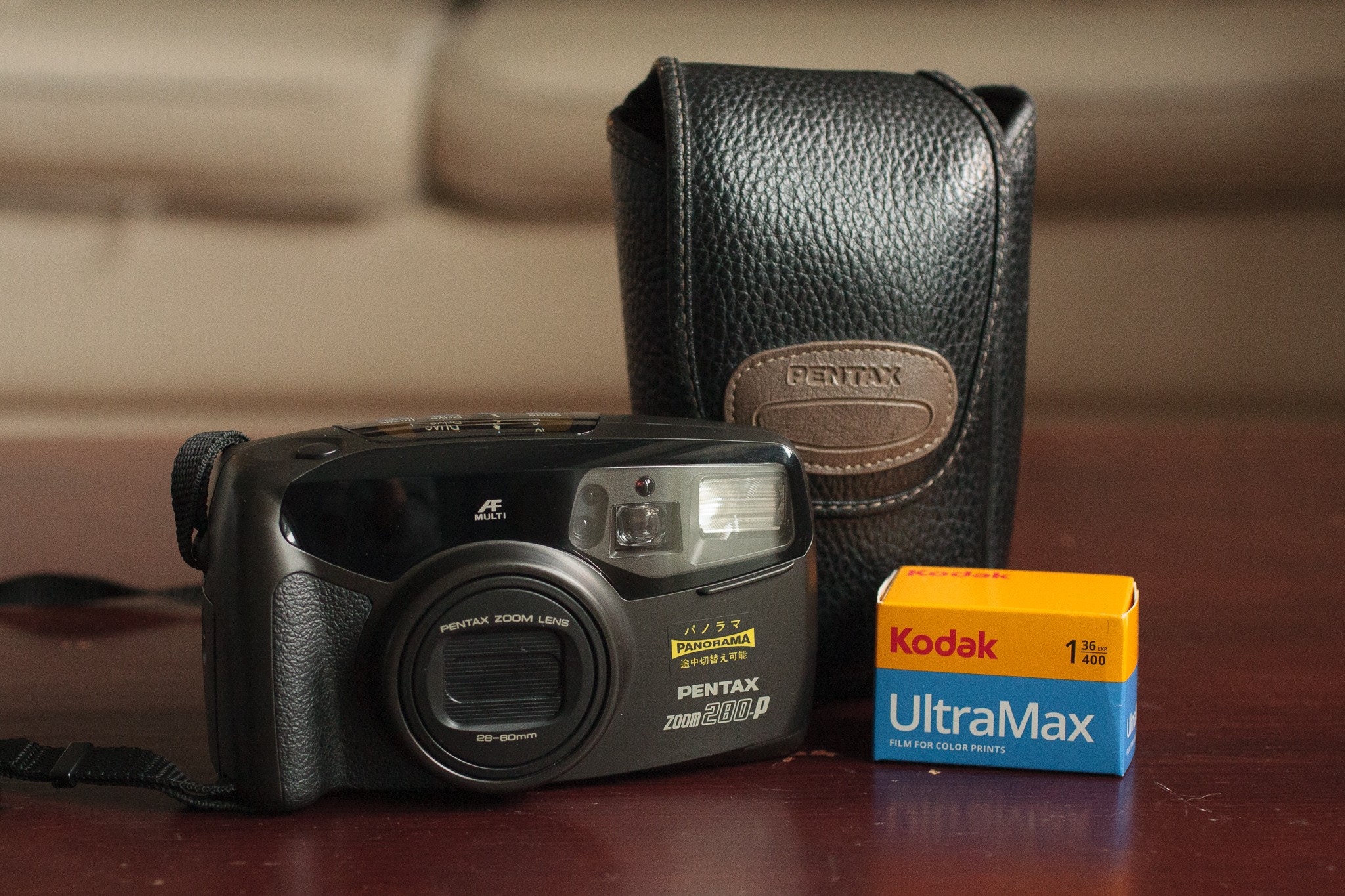Cover: Mr. Duck having a photoshoot with the Penguin.
This time I will tell you about a camera I picked up a couple years ago. I was looking for a nice compact camera with flash to take on trips and for party photos. Then I came upon this interesting looking Pentax Zoom 280-P for 30 euros in an online flea market, so I decided to grab it.
I have never owned a Pentax camera before, but I remember my mom had one with which she took practically all our family photos when I was a kid. Pentax is most well known, at least in the film photography scene, for their line-up of very highly regarded Asahi Pentax cameras and lenses and the legendary Pentax 6x7 medium format film camera. Founded in 1919 in Tokyo, Japan, it is currently owned by Ricoh, another camera company that currently makes very popular GR-series of digital cameras. Against this background, I had confidence in buying this camera.

Specs & overview
At first glance, the camera looks a bit boring hunk of black plastic. It's also not the most compact camera in its class, or lightest at 410 grams. But in exchange for that, it has a nice, comfortable grip that is good to hold on to, and buttons and other controls that are very easy to use as they are spaced out generously.
I especially like the zoom rocker switch that feels more natural to use than the more common implementation of using buttons. The build quality feels sturdy enough, but I wouldn't dare dropping it on concrete. The camera is not going to win any design awards, but is very practical.
The lens has a versatile zoom range of 28-80mm, with a decent aperture of f3.5 on the wide end, and f8 on the tele end. So not exactly a low light speed demon, especially on the tele end, but totally usable for daytime snaps and even evening if using the wide end of the zoom range.

Buttons, so many buttons
On top you will find all the function buttons to set different options, and a big number to tell you how many shots you've taken so far (it's up to you to remember how many shots your roll has in total).
There's four buttons, as the camera comes absolutely packed with features:
- Mode cycles through the auto mode, normal (?) mode, night mode without flash, and bulb without flash. The bulb mode is especially rare in compact cameras.
- Flash button has typical options for auto flash, no flash and red eye reduction flash.
- Drive button has a timer, burst, double exposure, and even interval timer (take many photos in succession with breaks between, adjustable between 10 seconds and 60 minutes). So cool! I haven't used the different functions yet, but they open up a lot of creative possibilities.
- Image button has options for different AF settings, such as portrait, landscape and something called Spot AF. I haven't tried any of these either, but can imagine the landscape setting being useful sometimes, when you want to be sure the camera will focus at a distance.
As is typical for compact cameras, the camera resets all settings to auto on shutdown. Sometimes it might be annoying, but on the other hand, you probably wouldn't want to accidentally start a 60 minute interval exposure when you grab the camera next time on your way to a party.


Panorama mode
One feature that caught my eye when picking up the camera, is the panorama switch by the viewfinder. Despite the cool name, all it does is add black bars on top and bottom of the image, to give it a panoramic aspect ratio. I have certain nostalgia for this feature, as my very first film camera (a Kodak using APS film cartridges) I got in 1999 had this feature.
In practice, it's a lot more fun than you might think! It also blocks out the relevant parts in the viewfinder, so you see the effect when taking photos. I find it helps me compose the pictures with this wide angle mindset, so sometimes the pictures actually turn out better in my opinion.



The viewfinder itself is not the smallest I've seen, but not big either. It's good enough :)
Image quality
Old compact cameras can be quite a hit or miss when it comes to image quality. Sticking to well-known brands is usually a safe bet, and this camera carries the Pentax name with pride. While I don't think it's up there with the very best, it certainly can take beautiful photos. Vignetting on the wide end is visible if you look for it, but not so much that it would distract. I'm not sure if it can be credited solely to the lens, but the photos came out crisp and colourful.


Out of the 36 exposures on the roll taken in very different scenarios, I had 2 or 3 that didn't quite focus correctly. And I was always shooting in full auto, so I'd say we have a winner here.
I feel like this camera excels in auto exposure. Photos came out just right in basically every situation I threw at it. Night time is a challenge of course, but I got good results even on Kodak Gold, which has an ISO of 200.



Flash photography
A lot of people buy compact cameras for those party photos with some V I B E S. Including me. Phones don't have very good flash, so that already makes real cameras much better at a party. And there's also more meaning behind the photo, because everyone knows there's only a limited amount you can take.
Based on my experience, the camera definitely passes the bar for a party camera. It even has a party trick up it's sleeve!


Remote control (yes, you read that right)
Pentax in their great wisdom had the imagination to think of putting one more feature to this camera. A detachable remote! I was so stunned when I found out about it. No worrying about it getting lost, as it inconspicuously attaches to the camera body. How neat is that!

After switching the dead battery (a CR1620), I tried the remote and it worked without an issue. (Funnily enough it states in the manual that you should replace the remote battery in the Pentax Service facility. I wonder if there still is one somewhere?) It even has some kind of zooming functionality I think, but I have yet to try that. Very impressive indeed.

Overall impressions
Pentax Zoom 280-P is one of the many compact cameras from the 90s that seem all but forgotten. Maybe it's the sheer amount of similar looking, similarly functioning cameras that it's hard to even remember which one with a cryptic name-number combination you used last time.
But if you're open to look beyond the most popular choices and maybe overlook the frankly unimpressive looks, you can still find really good deals out there and get a solid camera, that will likely work for years to come. Based on my very shallow internet research, Pentax compacts don't seem to suffer from dying electronics that often.
The camera is comfortable and easy to use and simply delivers. It doesn't quite fit into a jeans pocket, but a small bag or jacket pocket is fine, which is something to consider, if you're looking for a really compact one. Other than the size, it doesn't really have any shortcomings, and comes packed with features (some more useful than others). Despite the somewhat gimmicky panorama feature, I found myself using it quite often.
Overall, the camera is strong where it matters the most: ease of use, good image quality and reliability. I highly recommend it for a budget do-it-all compact camera.
Sample photos







